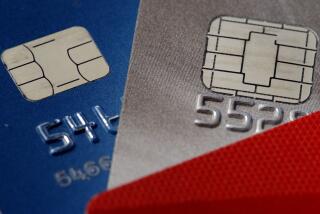The Problem With Secured Credit Cards
- Share via
Those who have had trouble getting credit got some good news recently. Citicorp, the nation’s biggest banking company, is starting to offer secured credit cards.
Although Citicorp calls the offer a “limited test,” the big bank’s entree could open the market to tens of thousands of individuals who have no access to credit cards either because of past problems or simply because they haven’t had a chance to develop a credit history.
Only about 25 banks and thrifts now offer secured cards, and, by and large, they are small institutions that issue only a few thousand cards a year. There are fewer than 500,000 secured cards outstanding today, compared to more than 250 million ordinary credit cards.
To get a secured card, consumers must deposit money in the bank as collateral. Sometimes they earn interest on the deposits; sometimes they don’t.
Individuals then must pay the annual fees, application fees and, if there is a revolving balance, the interest charges normally associated with credit cards. Often these fees and interest charges are far higher for a secured card than for normal credit cards.
There are some exceptions. A few banks offer lower-than-market rates on these cards. And some--including Citibank--charge the same for a secured card as they do for standard credit cards. But often these more attractive offers are available only to a select few. San Francisco-based United Savings, for example, offers a secured card at a 10% interest rate. But the thrift issues the cards only to those who have clean credit records.
Bank of Elmhurst in Elmhurst, Ill., offers a card at a 15.9% rate, but only to current customers who have yet to establish a credit history. Those with bad credit need not apply. And Citibank is picking and choosing its customers and offering its secured program only to those it contacts by direct mail. But no matter the rate, consumers are wise to question whether secured cards are worth the cost. The benefits of the cards are limited.
What are you getting with a secured card? A second form of identification. And the ability to buy on credit. If you need to establish a credit record or want to repair a marred financial history, secured cards can also help.
What you are not getting is the additional financial wherewithal that you normally buy when you pay those exorbitant rates for a standard credit card. When you have a standard credit card, you can borrow money that you don’t have. With a secured card, you are, in essence, only using money you already have. And you are paying a huge fee to allow a banker to serve as a middle man.
To illustrate, let’s look at an example.
Bank of Hoven in Hoven, S.D., is one of the nation’s biggest secured card merchants. The bank charges 21% on any credit balance outstanding for more than 25 days, as well as a $39 annual fee and a $69 application fee. If you go over your credit limit for more than 25 days, there’s an additional $15 “settlement” charge.
To get one of these cards, you must open a savings account and leave $380 to $2,500 on deposit. The amount of your deposit equals your credit limit on the bank card. The bank is paying 4.5% on these deposits.
Let’s say you leave $500 on deposit and pay off your balance each month so you never pay interest charges. At the end of the year, you will have earned $22.50 on your deposit, and you will have spent $108 on credit card fees. Net loss: $85.50. (The loss drops to $39 in the second year, if you continue to pay off the card balance, since you don’t have to pay the application fee.)
What happens if you have to borrow on the card? If you borrow $500 for the year and you have $500 on deposit, your net loss amounts to $190.50. That’s $108 in fees and $105 in interest charges, minus the $22.50 you earned on your deposit.
Even the seemingly good deals aren’t so great if you stop to figure them out.
Consider the United Savings card, which offers a surprisingly low 10% rate. To get one, you must deposit at least $1,000 in a 5% savings account. Your credit limit is half that. If you borrow up to your limit, the interest paid on the loan and the interest you earn on your account cancel out. Good deal? Not really.
The only reason you bought on credit was because you couldn’t pay with cash. Your cash was locked up in the bank deposit securing your credit card. If you’d simply paid the $500 bill with cash and deposited the other $500 in a 5% account, you would have saved the $20 fee and earned an additional $25 in interest.
Of course, if you are trying to establish or repair your credit, you may have few other choices. Your best bet, though, is to get rid of the secured card as soon as you can.
Security Blanket Issuers of secured credit cards require their customers to make a deposit into a savings account for collateral. Consumers who are establishing or rebuilding credit find that such cards often are the only way to get credit. The following banks are among those offering secured credit cards:
American American National Pacific Bank of Bank One Bank Bank Hoven of Lafayette Cards Offered Visa Visa Visa Visa MasterCard MasterCard Interest Rate 19.80% 18.90% 21.00% 19.80% Annual Fee $69 $30 $35 $35 Application Fee None None $65 None Min. Deposit $500 to $400 $380 to $300 to $5,000 $2,500 $2,500
Source: Ram Research’s Cardtrak
More to Read
Inside the business of entertainment
The Wide Shot brings you news, analysis and insights on everything from streaming wars to production — and what it all means for the future.
You may occasionally receive promotional content from the Los Angeles Times.










